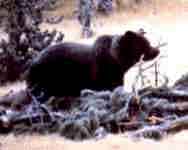- Home
- About S&T
- Taxa/Organisms
- Ecosystems
- Issues
- Methods & Tools
- Reports & Publications
- Location
- Search
2008 | Publisher: USGS | Science Center: Fort Collins Science Center (FORT, Ft. Collins) | Format: URL
www.fort.usgs.gov — With the exception of Aspen, coniferous species dominate the forests of the Rocky Mountains (Populus tremuloides Michx.; Peet, 2000). The establishment of new aspen stands in the central Rocky Mountains generally follows major disturbances, particularly forest fires, with new stems sprouting from surviving root systems and with rare establishment More...

2008 | Publisher: USGS | Science Center: Fort Collins Science Center (FORT, Ft. Collins) | Format: URL
www.fort.usgs.gov — Irreplaceable resources such as water, timber, biodiversity and recreational opportunities are all being affected by the earth's global changing climate. Ecological disturbances - wildfire, insect outbreaks, and the spread of invasive species - are also accelerating and changing the earth's ecosystems. US Geological Survey (USGS) and US Fish and More...

2007 | Publisher: Other (Ecological Society of America) | Format: .PDF
www.nrmsc.usgs.gov — Every winter, government agencies feed ;6000 metric tons (63 106 kg) of hay to elk in the southern Greater Yellowstone Ecosystem (GYE) to limit transmission of Brucella abortus, the causative agent of brucellosis, from elk to cattle. Supplemental feeding, however, is likely to increase the transmission of brucellosis in elk, and may be affected by More...

Publisher: USGS | Format: URL
pubs.usgs.gov — This study examines the winter ecology of the western burrowing owl (Athene cunicularia hypugaea) in five Texas counties surrounding Corpus Christi, in southern Texas. There is a substantial gap in information on the owl's life cycle during migration and non-breeding winter months; almost all previous research on western burrowing owls has been More...

Publisher: USGS | Science Center: Northern Rocky Mountain Science Center (NRMSC, Bozeman) | Format: URL
nrmsc.usgs.gov — This research summary gives an overview of sign surveys to detect bear population trends in designated wilderness and national park lands. The Northern Continental Divide Ecosystem has the best long-term prospects of supporting a viable grizzly bear population among the six areas designated as grizzly bear recovery zones in the United States. Yet More...

Publisher: USGS | Science Center: Northern Rocky Mountain Science Center (NRMSC, Bozeman) | Format: .PDF
nrmsc.usgs.gov — This web publication describes the Noninvasive Methods to Monitor Bear Population Trends. The U.S. Geological Survey is beginning a new grizzly bear research project this summer in the Northern Continental Divide Ecosystem (NCDE) of northwestern Montana. This work is based on hair collection and DNA analysis methods similar to those used in the More...

Publisher: USGS | Science Center: Fort Collins Science Center (FORT, Ft. Collins) | Format: URL
www.fort.usgs.gov — Encroaching development, overuse, and air- and waterborne contaminants from outside park boundaries are causing noticeable changes to water quality and ecosystem health and functioning. The Front Range metropolitan area from Fort Collins south to Colorado Springs includes 75 percent of Colorado's population and its most productive agricultural More...

Publisher: USGS | Science Center: Southwest Biological Science Center (SBSC, Flagstaff) | Format: URL
sbsc.wr.usgs.gov — The Internet Map Server (IMS) visually displays the non-native, invasive plants (weed) occurrences in the current (2003) SWEMP database. An IMS allows you to interactively draw, query, and print maps. The SWEMP IMS was developed from ESRI's ArcIMS presentation product.The Southwest Exotic Plant Information Clearinghouse is a cooperative effort More...

Publisher: USGS | Science Center: Biological Informatics | Format: URL
biology.usgs.gov — This web page presents samples of genetics and genomics research from the USGS Biological Resources Discipline about the conservation genetics of plants.

Publisher: Other Federal Agency (United States Forest Service (USFS)) | Format: .PDF
www.fs.fed.us — USGS scientist Jon Keeley led a team of scientists from various agencies and academic institutions in developing a framework that will inform fire management of ecosystems. This review uses a scientific synthesis to provide an ecological foundation for management of diverse ecosystems. Ecosystem-based management requires different strategies on More...

Publisher: USGS | Science Center: Northern Rocky Mountain Science Center (NRMSC, Bozeman) | Format: URL
nrmsc.usgs.gov — Northern Rocky Mountain Science Center has been monitoring, conducting research, and modeling ecosystem responses to climatic variability since 1991, first at Glacier National Park but eventually throughout the western U.S. in collaboration with other scientists. Coordination with scientists around the world have led to mountain research networks More...

Publisher: Academic Institution (Academic Institution(University of Washington-Seattle Campus)) | Format: .PDF
www.cfr.washington.edu — The Western Mountain Initiative is a team of USGS and USDA Forest Service scientists working together to better understand and predict the responses of Western mountain ecosystems to climatic variability and change, emphasizing sensitivities, thresholds, resistance, and resilience. The objective of the Western Mountain Initiative (WMI) is to More...
